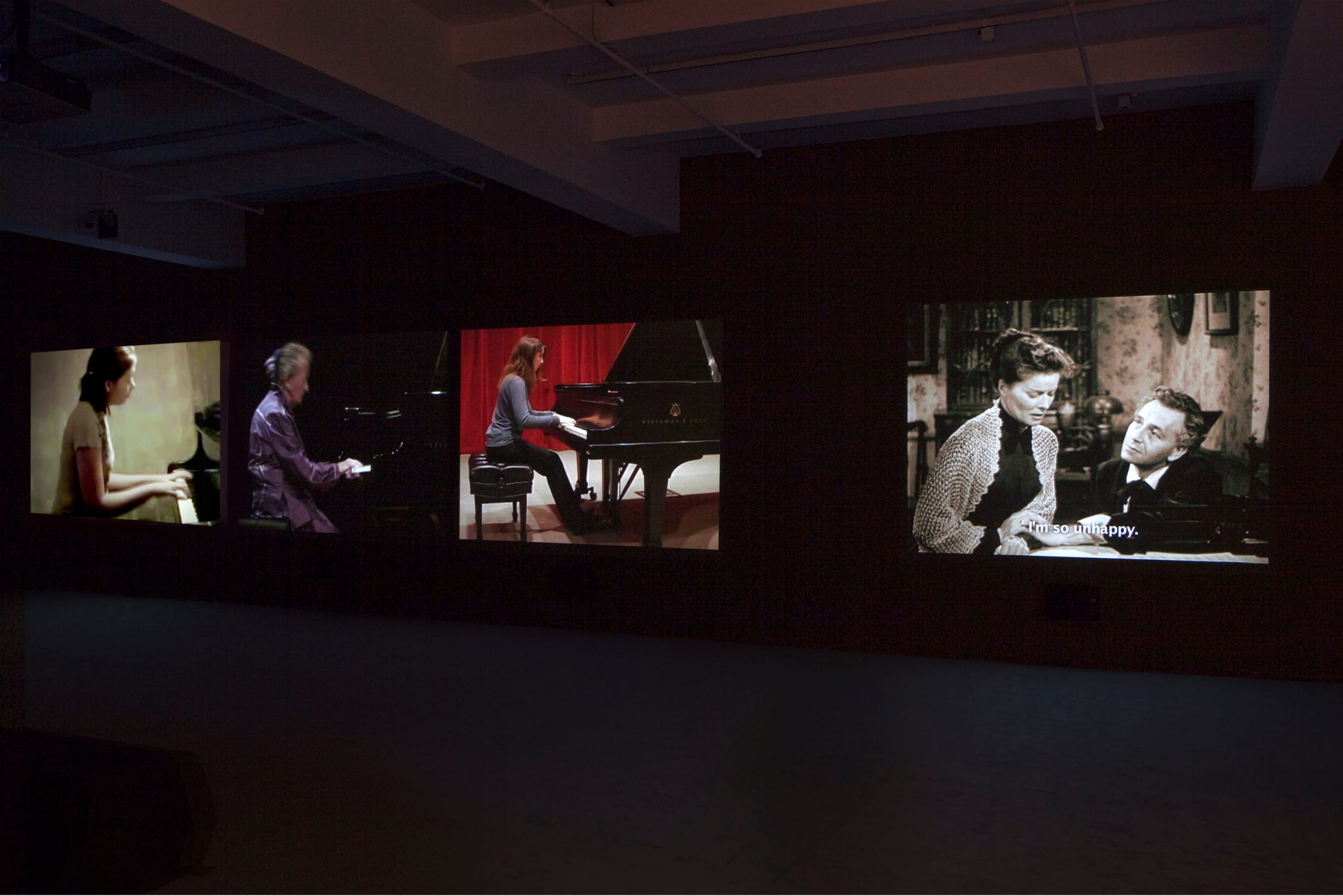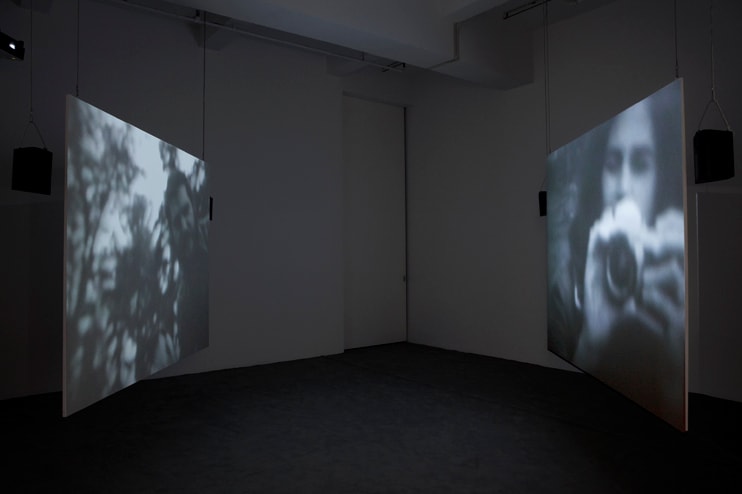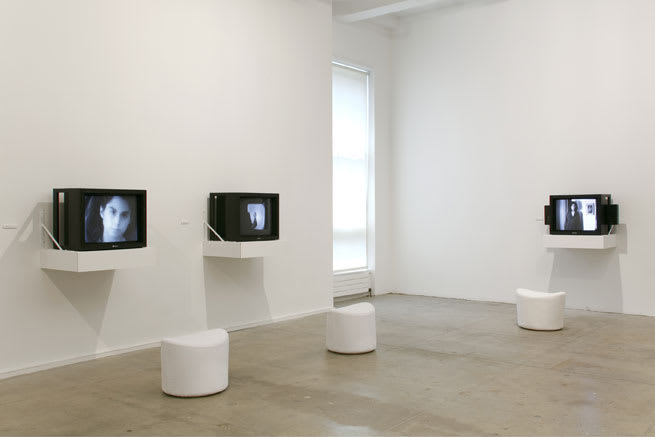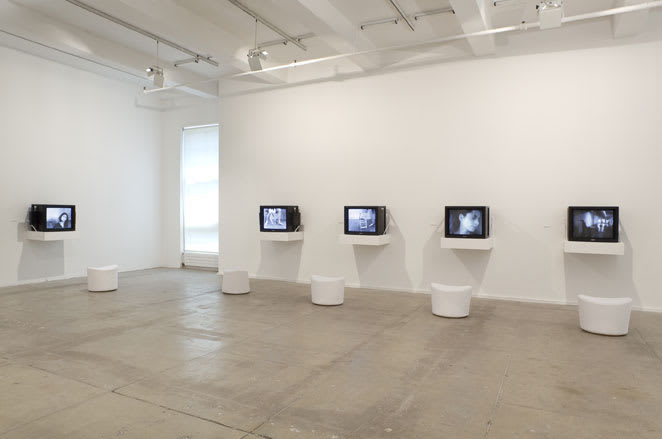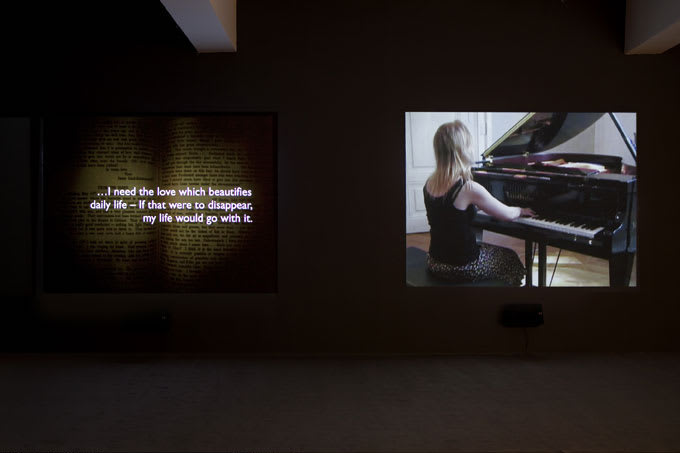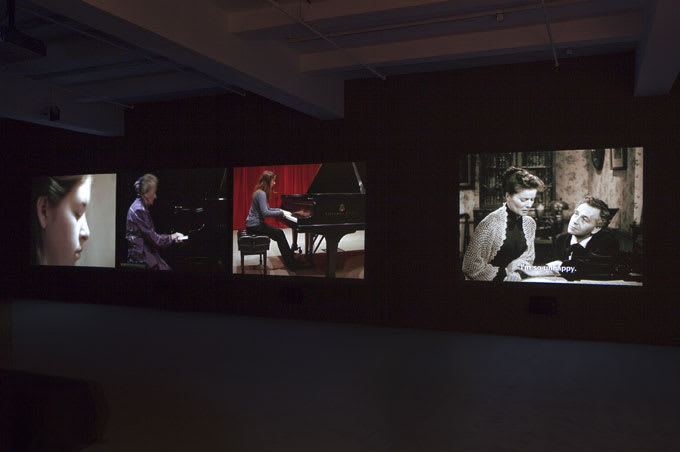Overview
Marian Goodman Gallery is delighted to present one of the first solo exhibitions of Dara Birnbaum’s work. The exhibition will showcase Dara Birnbaum’s most recent multi-channel work from 2011, Arabesque, in conjunction with a selection of her earliest single channel works from 1975/76, offering us a rare opportunity to view her earliest investigations in media while considering the continuity of her artistic practice over the past three and a half decades.
Dara Birnbaum: Arabesque, 2011
June 28 – August 26, 2011
Opening Reception: Tuesday, June 28, 6-8 pm
Marian Goodman Gallery is delighted to present one of the first solo exhibitions of Dara Birnbaum’s work in New York since 2001, following her large European retrospective Dara Birnbaum: The Dark Matter of Media Light at S.M.A.K./Stedelijk Museum voor Actuele Kunst, Ghent and Serralves Foundation, Porto, 2009-2010.
The exhibition will showcase Dara Birnbaum’s most recent multi-channel work from 2011, Arabesque, in conjunction with a selection of her earliest single channel works from 1975/76, offering us a rare opportunity to view her earliest investigations in media while considering the continuity of her artistic practice over the past three and a half decades.
Arabesque, 2011, will be presented in the North Gallery. It is a multi-channel video installation which reflects upon the legacy of two piano compositions: Arabesque Opus 18, composed by Robert Schumann for his wife Clara, and Romanze 1, Opus 11, composed by Clara Schumann for her husband Robert. The work highlights the differing receptions that each composition has had throughout history, juxtaposing video clips of respective performances culled from YouTube footage, presented contrapuntally, set against still footage from the 1947 film Song of Love’, a melodrama which also features Arabesque. Robert Schumann’s composition is widely recognized as a masterpiece, whereas Clara Schumann’s work of similar virtuosity has been largely forgotten. In her research on the internet, Dara discovered a disproportionate number of videos in favor of Arabesque, over Romanze 1. As she says, “The more the viewer is exposed to the masterwork (the Arabesque masterpiece), the more it becomes neutralized by the diverse range of musicians attempting to reach for it.”
Birnbaum continues, “It is perhaps unusual that I have reached for such a romantic composer as Schumann during such irrational political times that we are going through. Perhaps it is just because of this that I chose a rather isolated self-reflective person, who in the end went mad. Also I have always been concerned with the power struggle between male and female in my work. Clara Schumann was a most accomplished pianist and gave Robert his start. She is not as well known for her own compositions, which are also extremely good. One could argue that the “Arabesque” and “Romanze 1” are equally excellent compositions. They wrote the works for each other. Yet, when I started this work you could find only one person on YouTube playing the Clara Schumann composition; whereas there may be a hundred (men and women) playing the ‘Arabesque’. Also, it was Clara who had to carry on when Robert went through his periods of depression and madness and eventually died – she took care of the family (they had 8 children) and supported them through her playing. I have always been interested throughout much of my work in this ‘voice’ of the woman.”
In the North Gallery viewing room, Attack Piece (1975), a two-channel video work and Birnbaum’s first surviving installation, is an investigation into the formal differences between film and still imagery through the use of gender stereotypes. Birnbaum, seated and ‘armed’ with a still camera, is filmed by her mostly male collaborators (Dan Graham, Ian Murray, and David Askevold, among them), who attempt to invade her territory. Attack Piece foreshadows Birnbaum’s later preoccupation with ‘talking back to the media’, as well as her analysis of the media’s exploitation of the role of women, seen in early works such as Technology/Transformation: Wonder Woman (1978/79).
In the South Gallery, a series of Birnbaum’s earliest single channel video works from the 1970s will be shown. These include Mirroring (1975), Control Piece (1975), Chaired Anxieties (1975), Bar(red) 1975, Pivot: Turning Around Suppositions (1976), Everything’s Gonna Be Alright (1976), and Liberty: A Dozen or So Views (1976). Birnbaum’s early interest in video to create a psychological self-portrait can be seen in Mirroring, and likewise in Control Piece, in which the physical expression of such a state within a given space is revealed. Works such as Chaired Anxieties, Bar(red , and Pivot: Turning Around Suppositions reveal her sustained interest in the performative as well as the psychological, and the relationship between the camera and its subject. Each work in various ways addresses the formal structure between the camera, performer, and viewer and the attendant corollaries for gendered role play. Everything’s Gonna Be Alright marks a turning point in the artist’s work, a shift towards appropriation and the political that prefigures later works concerned with the cultural significance of pop culture and mass media imagery. All of the early video works have been generously restored by Electronic Arts Intermix (EAI), New York.
Sculptural and architectural in nature, Birnbaum’s approach to video and installation evolved from early studies in architecture and environmental design in the 1970s in San Francisco where she worked for Lawrence Halprin, after her graduation from Carnegie Mellon University. “At the time I was reading the Italian architect Manfredo Tafuri who stated that he felt television was the real architecture of the time. And that hit me very hard. In the workshops I was doing with Lawrence, there was a lot of video being used, mainly for documentation…. I asked Larry why we couldn’t use it to converse with the public.” Later, in 1975 during a period in Florence, she came in touch with the work of Vito Acconci, Dennis Oppenheim, Dan Graham and others, through the art gallery Centro Diffusione Grafica and was inspired to begin to work with video herself. By the mid-seventies, Birnbaum says, it was necessary to consider the structural aspects of television: “What really needed to be talked about was the language of television because that was the contemporary language of the U.S. and many other technologically advanced countries. The Nielsen ratings at that time, in the mid-1970s, said that the average American was watching television 7 hours and 20 minutes a day. That’s what I felt I had to go after.”
Over the past three and a half decades, Dara Birnbaum has achieved international recognition for her pioneering exploration of media vocabulary and the media’s representation of the female subject in particular. Her work has been influential for generations of artists. Using rigorous tactics of deconstruction and appropriation, Birnbaum was one of the first artists to subvert and critique the language of television and to ‘talk back to the media’ using its own language – seen in the seminal Technology/Transformation: Wonder Woman, 1978/79 and Kiss the Girls: Make them Cry, 1979. In her video-installations of the mid-80’s, such as in Damnation of Faust, she started to explore the expressive potential of video imagery, creating evocative meditations on her mostly female subjects which were later seen in such works as Erwartung/Expectancy, 1995/2001. Later installation works have used politically decisive moments as their touchstone, such as Hostage (1994) about the Baader Meinhof Group in relation to Hans Martin Schleyer, Transmission Tower: Sentinel (1992), which was commissioned by Documenta IX, and Tianamen Square: Break-In Transmission (1990), a ground-breaking examination of the role of the media in the Chinese student uprisings.
In the era of Twitter, Facebook, YouTube, and the Internet, the original ‘pirateer of TV images’ remains singularly committed to working with media that is of continued relevance to our times.
Born in New York in 1946, Dara Birnbaum received a Bachelor of Architecture from Carnegie Mellon University, Pittsburgh in 1969; a B.F.A. in Painting from the San Francisco Art Institute in 1973; and a Certificate in Video and Electronic Editing at the Video Study Center at the New School for Social Research, New York, in 1976. She has been the recipient of numerous distinguished awards, including most recently, a Rockefeller Creative Artist Residency earlier this year, the highly prestigious United States Artists Fellowship in 2010, and a Pollock Krasner Foundation Grant in 2011. In the past, she won the American Film Institute’s Maya Deren Award for Independent Film and Video Artists; the Special Jury Prize-Deutsche Videokunstpreis, Südwestfunk TV & Zentrum für Kunst und Medientechnologie; the TV Picture Prize, International Festival of Video and Electronic Arts in Locarno, Switzerland; among many others.
Recently, an important retrospective of her work was presented at S.M.A.K. / Stedelijk Museum voor Actuele Kunst, Ghent (2009), which traveled to the Museo de Arte Contemporaneo de Serravles (2010). Published in conjunction with this exhibition is the catalogue Dara Birnbaum: The Dark Matter of Media Light. Solo exhibitions have been seen at The Jewish Museum, New York; IVAM Centre Julio Gonzalez, Valencia; Kunsthalle Vienna. Recently, she was included in Off the Wall: Part 1 at the Whitney Museum, as well as Modern Women: Single Channel at MOMA/PS1, and The Pictures Generation: 1974-1984 at The Metropolitan Museum of Art.. Her work has been shown at The Museum of Modern Art, NY; Whitney Museum of American Art, NY; Centre Georges Pompidou, Paris; Tate Gallery, London; Moderna Museet, Stockhom; Stedelijk Museum, Amsterdam; among many others.
Please join us at the opening reception on Tuesday, June 28th from 6 -8 p.m.
For further information, please contact the Gallery at: 212 977 7160.
